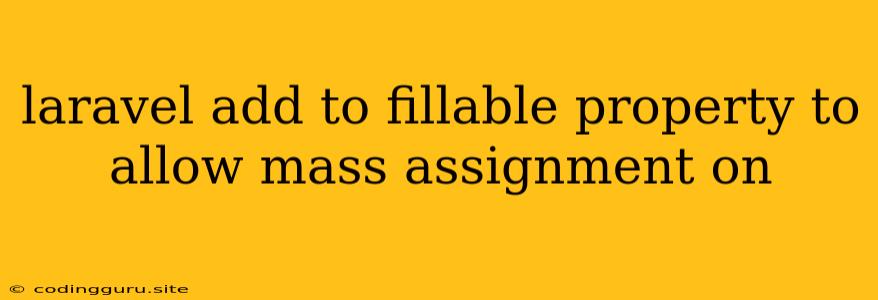Laravel: Adding Properties to Fillable for Mass Assignment
In the realm of Laravel development, ensuring the security of your applications is paramount. One crucial aspect of this security is controlling which attributes are allowed to be mass assigned. This is where the fillable property within your Eloquent models comes into play.
What is Mass Assignment?
Mass assignment is a convenient way to create or update multiple attributes of your model in a single operation. It allows you to pass an array of data to your model's create or update methods, and Laravel automatically assigns the values to the corresponding model attributes.
Why is it Important to Control Mass Assignment?
While mass assignment simplifies development, it also introduces a potential security vulnerability. If you don't explicitly define which attributes can be mass assigned, attackers could exploit this by sending malicious data that could overwrite critical model attributes, leading to data breaches or unauthorized modifications.
The Power of fillable
Laravel's fillable property acts as a safeguard against this potential vulnerability. It allows you to explicitly define the attributes that are permitted to be mass assigned. By specifying the fillable array in your model, you ensure that only these attributes can be updated or created through mass assignment.
How to Add Properties to fillable
Adding a property to the fillable array is a straightforward process. Let's illustrate with a simple example:
*/
protected $fillable = [
'name',
'email',
'password',
];
// ... other model methods
}
In this example, we have a User model with three attributes: name, email, and password. By adding these attributes to the fillable array, we've made them eligible for mass assignment.
Adding a New Property to fillable
Let's say we want to add a new attribute called bio to our User model. To make this attribute mass assignable, simply add it to the fillable array:
*/
protected $fillable = [
'name',
'email',
'password',
'bio', // Added bio to fillable
];
// ... other model methods
}
Now, you can safely use mass assignment to create or update bio along with the other fillable attributes.
Mass Assignment in Action
Let's see how we can utilize mass assignment with our updated User model:
// Create a new user
$user = User::create([
'name' => 'John Doe',
'email' => '[email protected]',
'password' => 'password123',
'bio' => 'A passionate developer with a love for open source.',
]);
// Update an existing user
$user = User::find(1);
$user->update([
'name' => 'Jane Doe',
'bio' => 'A talented software engineer with a passion for building innovative solutions.',
]);
In these examples, we're using the create and update methods to assign values to the attributes specified in the fillable array.
Important Note:
While the fillable property protects against malicious mass assignment, it's essential to carefully consider which attributes you add to it. Only include attributes that are safe for mass assignment. You can also use the guarded property to specify attributes that are never allowed to be mass assigned.
Conclusion:
Adding properties to the fillable array in Laravel is a crucial step in maintaining security. By explicitly defining which attributes are mass assignable, you mitigate potential risks and ensure that your application remains protected from malicious attacks. Remember to carefully consider the attributes you include in fillable and prioritize security when designing your models.
